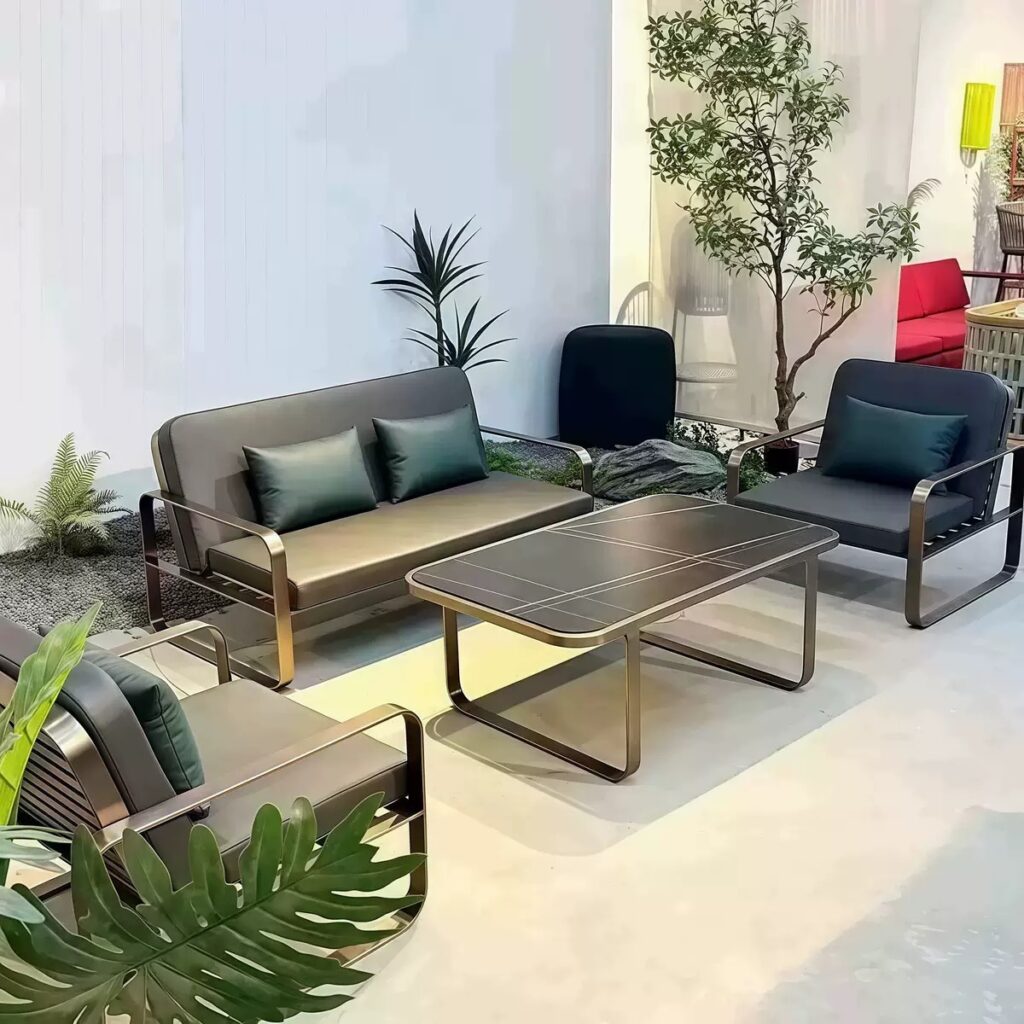Outdoor sofas: When creating an ideal outdoor leisure space, outdoor sofas are indispensable core furniture. The choice of appropriate materials not only affects the appearance and comfort but also directly relates to durability, water resistance, sun protection, and the convenience of daily maintenance. This article will introduce several of the most common and suitable materials for outdoor sofas to help you make a scientific choice.
Outdoor sofas best materials
Aluminum alloy (aluminum)

Features: Lightweight, rust-proof, and easy to move.
Advantages: Strong anti-oxidation performance, suitable for humid or rainy environments; modern design, easy to match.
Suitable for: Families and outdoor cafes that pursue lightness and modern style.
Solid wood (teak/acacia and other hardwoods)

Features: Natural texture, high-end, and elegant.
Advantages: Teak wood contains natural oils, which endow it with anti-corrosion and anti-insect properties; it has a warm and natural visual effect.
Precautions: Regular oiling maintenance is required to prevent cracking and fading.
Suitable for: Users who pursue a natural atmosphere and a garden courtyard style.
Wicker (Rattan / PE Rattan)

Features: Classic outdoor furniture materials.
Advantages: Lightweight and breathable, suitable for hot summers; nowadays, PE rattan is often used, which is waterproof, sun-proof, and has a longer lifespan.
Suitable for: Families and vacation hotels that prefer a casual and vacation style.
Stainless Steel

Features: Sturdy and durable, with strong load-bearing capacity.
Advantages: Corrosion-resistant, suitable for harsh environments, and modern and simple style.
Precautions: Relatively heavy and inconvenient to move.
Suitable for: Large outdoor spaces that prioritize stability and safety.
Outdoor Fabric
Common types: Olefin, Sunbrella, Textilene, etc.
Advantages: Waterproof, sun-proof, mold-proof, good breathability, and rich color options.
Applications: Often used for sofa cushions and backrests to enhance comfort.
Wood Plastic Composite (WPC)

Features: A composite material of wood and plastic.
Advantages: Combines the texture of wood with the water-resistant and insect-proof properties of plastic; easy to maintain.
Suitable for: Users who need an economical, durable, and easy-to-clean material.
Comparison of Outdoor Sofa Materials
| Material | Advantages | Disadvantages | Best Use Cases |
| Aluminum | Lightweight, rust-resistant, modern look, suitable for humid environments | Not as strong as steel, some designs may deform | Balconies, gardens, poolside |
| Solid Wood (Teak, Acacia) | Natural texture, high-end look, resistant to decay and insects (e.g., teak) | Requires regular maintenance and oiling to prevent cracks and fading | Courtyards, gardens, villas |
| Rattan (PE Rattan) | Lightweight, breathable, waterproof and UV-resistant (PE rattan), cozy style | Natural rattan can mold easily; PE rattan is better for outdoor use | Resorts, leisure areas, hotel outdoor spaces |
| Stainless Steel | Strong and durable, high load capacity, corrosion-resistant, modern minimalist style | Heavy, difficult to move, relatively expensive | Large public spaces, commercial use |
| WPC (Wood Plastic Composite) | Waterproof, insect-proof, easy to clean, combines wood texture with plastic durability | Less natural feel compared to real wood, limited design options | Budget-friendly homes, outdoor restaurants |
How to choose the most suitable material for outdoor sofas?
Consider the climatic conditions.
In damp areas, it is recommended to choose aluminum alloy or PE rattan weaving.
- Aluminum alloy is lightweight, rust-proof, and not prone to corrosion, making it particularly suitable for southern or coastal areas.
- PE imitation rattan is more water-resistant and sun-resistant than natural rattan and is less likely to mold or crack. It is very suitable for high-humidity environments.
In dry areas: Solid wood (such as teak or acacia) is a good choice.
- Teak wood inherently contains oil and has natural anti-corrosion and anti-insect properties, with a high-end and elegant texture.
- However, it is necessary to pay attention to regular oiling and maintenance to avoid cracking due to dryness.
Consider the purpose of use.
Private balconies and small terraces: It is recommended to choose lightweight materials (such as aluminum alloy or PE rattan) for easy movement and cleaning.
For courtyard gardens and outdoor villas: You can choose solid wood or rattan weaving to create a natural and warm atmosphere.
Commercial spaces and large outdoor venues: Stainless steel or wood-plastic (WPC) is recommended.
- Stainless steel is sturdy and durable with strong load-bearing capacity, making it suitable for high-frequency use.
- WPC combines the wood feel with the durability of plastic. It is waterproof and insect-proof, easy to maintain, and suitable for dining or vacation places.
Consider the budget and cost-effectiveness.
- High-end budget: Solid wood (especially teak) + brand-name outdoor fabric (such as Sunbrella), which combines texture and durability, but the price is relatively high.
- Medium budget: Aluminum alloy + PE rattan weaving, which is both beautiful and practical, with a high overall cost performance.
- Economic budget: Plastic wood or ordinary fabric combined with basic waterproof fabric, suitable for users who are sensitive to price but still want to enhance the outdoor experience.
Other considerations
Maintenance difficulty
- For peace of mind, aluminum alloy, PE rattan weaving, and wood-plastic composites just need to bedaily.
- I like the natural feel → solid wood, but it needs regular maintenance.
Style matching
- Modern minimalist space: aluminum alloy, stainless steel.
- Natural vacation style: solid wood, rattan weaving.
- Business/Hotel → Wood-plastic, stainless steel.
Conclusion
When choosing the material for an outdoor sofa, factors such as climate, usage, budget, and maintenance should all be taken into consideration. If you have any custom sofa requirements, please contact NINGBO TOPRISE to help you solve the customization problems.


